One item often missing from the lobster table, but a real necessity, is the ‘detritus bowl.’ That’s the elegant blue plastic bucket you’ll notice in the background of the photo. Be sure to have one available . . .

If your plate has hot water all over the bottom, tip it into the detritus bowl. And then hold your lobster head down over the bowl for a minute. When the water (if any) stops draining, you’re ready to take this thing apart.
I like to start with the large claws. Turn your beast on its back.

Hold the body, grab the large claw leg joint closest to the body and give it a twist.
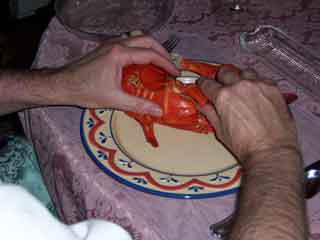
If it doesn’t come right off, give it a twist in the other direction, or twist back and forth a couple of times. It will come off.
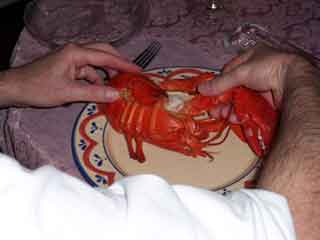
Hold it horizontally until you’re over the bowl and then hold it claw up for a bit to drain water. Do the same with the other one.
After the large claws are off, twist off each of the little claws. Again, just grab the joint closest to the body and give a twist (or three).

The little ones seldom have much water in them, so you don’t need to take the time to drain them. Just pile the little guys next to the big ones.

Now at this point, you have a difficult decision to make. Right now, all your lobster parts are still hot. If you dismantle the rest of the beast and remove all the meat before you start eating, everything will be cold when you get it in your mouth.
But if you remove meat and eat as you go along, you’ll be constantly switching gears between wrecking crew, surgeon and gastronome, your hands will be a mess throughout the entire meal, and by the time you get to the tail, it will probably still be cold.
Me, I always get all the meat on my plate first (and as fast as I am able) so I can concentrate on the eating part for the rest of the meal. You can make your own choice.
OK. All claws are off and the big ones have been partially drained. Some argue that since the tail will stay warm as long as it’s attached to the body, but the claws are already cooling off, that you should take the claws apart and get that meat soaking in the butter before tackling the tail. I prefer to take it all apart first.
So, over the bowl, grab the tail in one hand, the body in the other, do the old bend and twist a time or three.

When the tail comes off, tip it to drain, and drop the body into the bowl.
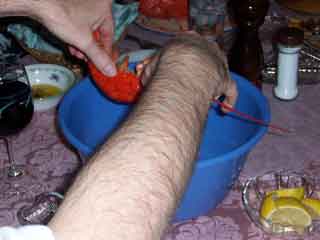
OK, OK, no hate mail, please. I know. There’s enough meat in the body to feed a family of four, or fourteen, depending on which old Yankee you listen to. I’m sure there is. I’ve never had the patience to dig it all out. If you do, feel free. But I’d recommend you save that task until you’ve finished eating the easy parts!
Now. Depending on the time of the year, the phase of the moon, the gender of your lobster, and probably nine other factors I know nothing about, you may, or may not, see some green ‘tamale’ and/or red ‘coral’ sticking out from the tail of your beast.
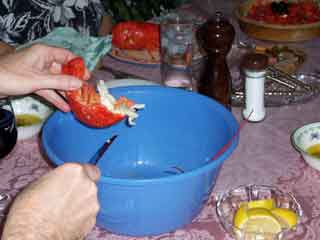
Yes, they are both edible. And many people consider them great delicacies. I don’t like the way either one tastes, so I scrape them both off into the bowl.

Next, split the tail. Just grab it on both sides, hooking your thumbs on the fins, and bend outwards.
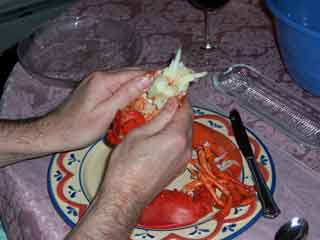
Keep applying pressure until you feel the shell start to split. If the whole tail spilts, then you’re done. Otherwise, move your grip down a little toward the tail fins and bend again. By that time, the tail meat should be easily visible.

Then, just grab on and tug. Boit. Out comes the entire lobster tail.
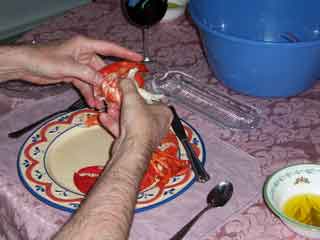
But you’re not done with that tail shell yet! See those little flipper fins at the end? Each one has a delicious little morsel of wondrously tender and tasty meat hidden inside. So bend off each one, drain it over the bowl, and put it on your plate.

Now. To ‘undo’ a claw, hold it over the detritus bowl, claw down, and bend up the ‘thumb’ part – that’s the smaller of the two pincers. If necessary, give it a nudge side to side as well as up and down.

When it snaps off, expect a gush of water to drain out of the leg and claw. Set the little one on your plate, and still over the detritus bowl, bend the rest of the claw free of the leg. Give both the claw and the leg a shake or two to get the last of the water out

At this point you may or may not need a claw cracker. Lobsters shed their shells when they outgrow them. The new shells are soft; the old shells are hard. If the shell is hard, you’ll hurt your hand and probably cut yourself trying to break the shell without a cracker. If the shell is soft, just grab the large claw and snap the pincer end off.

Because the lobster hasn’t had time to ‘grow into’ its new shell, the shell will separate easily from the meat. Drop the shell, tug the meat, and onto the plate.

To get the meat out of the leg joints, you may want to use a ‘lobster pick.’ But if you don’t have one handy, fingers, fork tines, knife points, toothpicks, or . . . will do just as well. Dig in, one end then the other. Pull (gently, gently . . .), push, wiggle and jiggle.

The meat will plop onto your plate.

Do the other claw the same way, and you’re ready to eat.
Cut the meat and toss it into the butter bowl. Or cut it and leave it on your plate for individual bite dunking. Salt it (very, very lightly), douse it with lemon juice, dip it or drown it in butter, or olive oil, or flavored oil, or simply eat it as it is. You will enjoy . . .
If you're going to drain the delicious juice you should be saving it for chowder or whatever you are making with left overs!
ReplyDelete